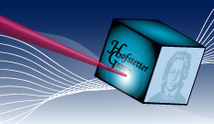Hybrid atom-ion systems
Both ultracold neutral atomic gases and ultracold ionic systems have enabled the simulation of a wide variety of quantum phenomena. In particular, atoms in optical lattices have served as a quantum simulator for lattice based models and their properties, such as s-wave interactions, can be finely tuned via additional laser couplings. Ultracold trapped ion systems on the other hand provide a remarkable degree of control and precise measurement and represent a universal quantum simulator through carefully prepared systems and the use of quantum gates.
These existing quantum simulators have their own difficulties however. Atomic systems usually provide no "back-coupling" to the optical lattice which precludes the observation of phonons. Furthermore long-range interactions are rather difficult to produce (although possible through the use of optical cavities or polar molecules) and precision measurements of local observables require complicated experimental setups. On the other side, simulating certain features in ionic simulators, such as fermionic statistics, can be technically challenging and it is difficult to scale the ion systems to large ion number (typical ion numbers are less than 100).
We have recently proposed a system that takes the advantages of both of atom and ion systems and combines them together, to be realised in the group of Rene Gerritsma at the Gutenberg-Universität Mainz. We consider a 1D chain of ions (which may also be extended to a 3D crystal) and place atoms trapped on top of the ion chain or at a small distance beside it. The result: a solid-state material simulator which features fermion-phonon interactions, sharply peaked electronic potentials and a high degree of tunability over all couplings in the system.

The ions, which are at the center of a Paul trap, are best described as an expansion about their classical equilibrium positions, which may be tuned towards a linear chain, a zigzag pattern or a 3D crystal depending on the trapping potential and geometry. Assuming small fluctuations about this equilibrium configuration, a phonon structure consisting of longitudinal and transverse modes can be derived (shown above).

The atom system is also trapped near to the ions and feels the classical potential generated by the ions in their equilibrium positions. This is a periodic potential and hence a band structure forms within the atoms. In contrast to other quantum simulators, this potential is locally of a 1/R^4 character due to the interaction between the charged ion and an induced dipole within the atom. Atomic band structures are shown above for a quantum defect theory treatment of this potential.
With both the separate ion and atom Hamiltonians transformed into their low energy forms, we come to the most interesting part of the system: the atom-phonon interactions. These appear in the Hamiltonian concisely as a result of the expansion of the atom-ion interaction, first in terms of ion displacement operators and thereafter in terms of phonon creation and annihilation operators:
|
|
 |
 |
|
We have demonstrated the effect of the fermion-phonon coupling on the system, albeit via a semi-classical calculation, by investigating a Peierls-like quantum phase transition into an ionic zigzag configuration. Seen below, this transition is a spontaneous symmetry breaking in the ion positions (here towards a zigzag configuration), such that the atomic band structure is split. Although the distortion of the ion string incurs an energy cost, the atoms offset this by minimizing their energy at rational fillings (here shown for half-filling). In solid-state materials, this often signals a transition to an insulating phase as the temperature is lowered.

References:
[1] U. Bissbort, D. Cocks, A. Negretti, Z. Idziaszek, T. Calarco, F. Schmidt-Kaler, W. Hofstetter, R. Gerritsma, Phys. Rev. Lett. 111, 080501 (2013).
[2] Press Release, http://www.phmi.uni-mainz.de/6883.php.





